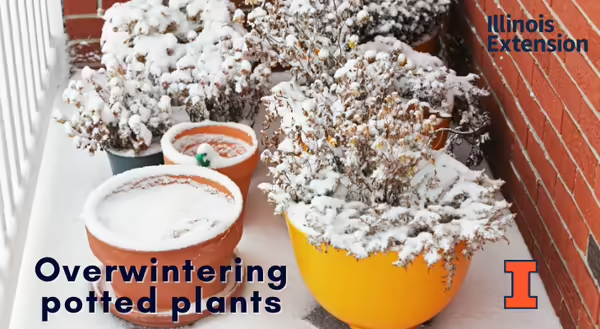
Have you ever gone a little overboard buying plants and run out of room or energy to plant them all in the fall and figured it could wait until spring, only to find out most, or all have died? Or maybe you’ve had a container planter with perennials and excitedly waited for them to resume growth in the spring, but it never happened.
Perennials in pots are subjected to much harsher conditions compared to those in the soil. Because of this, even if they are hardy to your area, they can be damaged and killed. Fortunately, there are some steps you can take to try to get these plants through the winter so you can enjoy them come spring.
The most common way is probably storing them indoors. Places like an unheated garage, shed, or cool/cold basement can be good locations to place potted perennials for the winter. Many perennials need a cold dormancy to properly bloom and grow, so if your garage or basement is too warm (temps should be between 20 and 45°F), you may need to look elsewhere. This is the best option for perennials that are not hardy to your zone.
A second option is to sink your pots into the ground. By placing your pots in the ground, the surrounding soil can insulate the pot (and the plant roots), protecting from extremely cold temperatures and temperature fluctuations. Additionally, the pots and plants can be mulched to provide additional protection. Once the danger of a hard frost has passed, the pots can be removed from their holes.
If digging a hole in the ground isn’t an option, or the pot is too large, you can group pots together in a protected location. Look for an area that doesn’t receive strong winds or too much sunlight (to prevent drastic temperature fluctuations), such as the north or east side of a building. Once you’ve clustered the pots, mulch them heavily with straw, leaves, or wood mulch. Once growth resumes in the spring, remove the mulch and return the pots to their rightful place.
Note: these steps are best for hardy perennials; non-hardy plants like geraniums may need to be handled differently
So why go through all this trouble? Most plants’ roots are far less cold hardy than their above-ground parts (stems and trunks). Usually, this isn’t an issue because the soil will insulate the roots and protect them from extreme cold temperatures (any snow cover will further insulate plants). While potted plants may be in a growing media, the amount of media is small and will get much colder than soil in a landscape.
Since potted plants’ roots are exposed to colder conditions than those in the ground, it’s a good idea to look for plants that will survive in a hardiness zone lower than yours. The general rule of thumb is to select plants that are two zones different than your zone. Depending on where you live in central Illinois, we are zone 5 or 6. Therefore, you would want a plant that is hardy to zone 3 or 4 if you plan to overwinter it outdoors in a pot.
Before getting pots ready to overwinter, make sure the plants inside are well watered, and check throughout the winter. This is especially important for evergreens to help prevent winter burn (desiccation). Even after above-ground growth has gone dormant for the year, the roots will continue to take up water. In addition to providing water to the plants, moist growing media will freeze slower than dry media, offering additional protection.
Good Growing Tip of the Week: Done with your pots for the year? Most containers can be damaged by freezing and thawing conditions if the growing media is left in them during winter. Remove the growing media from pots and store them upside-down to prolong their useful life.
Want to get notified when new Good Growing posts are available? SIGN UP HERE!